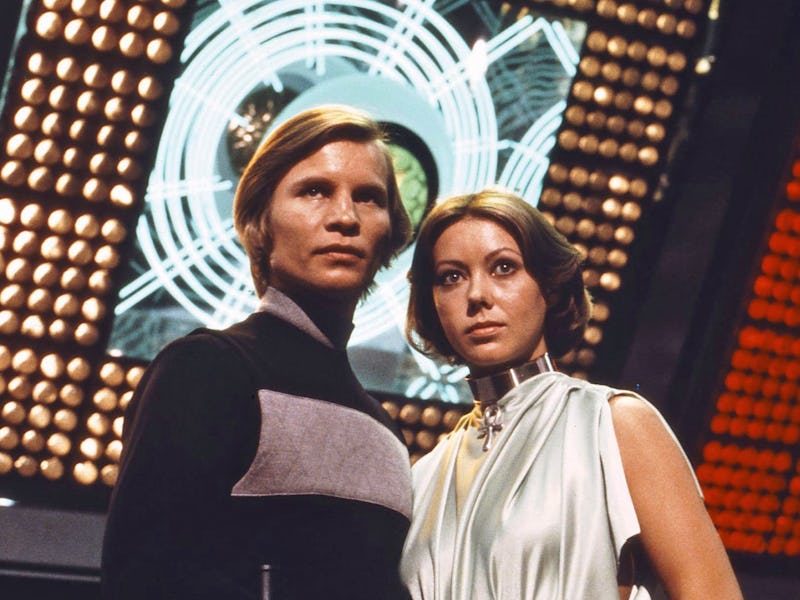You need to watch the best dystopian ‘70s sci-fi movie on HBO Max ASAP
Before Star Wars, this film set a precedent for sci-fi blockbusters.

What separates utopia from dystopia? If you’ve read or watched enough science fiction, the answer probably seems pretty simple. Utopias are a wonderful Jetsons-esque fantasy of humanity reaching their fullest potential. And dystopias are dire and dirty, a vision of Mad Max’s Wasteland. But what if a dystopia looked utopian? What if, behind the perfect walls of a crystalline city where people lived only for pleasure, there was something darker, a sinister truth that could shake the world’s very foundation if revealed?
The 1970s were a prime era for this kind of science fiction, full of third-act twists that drew inspiration from fears of nuclear holocaust, positing that humans would bury their evils and leave them lying in wait while pretending to advance as a society. Beneath the Planet of the Apes, Soylent Green, and Westworld are among the best-known science fiction films to open with the pretense of human advancement then reveal our species has remained the same or even devolved beneath the surface.
In 1976, a year before Star Wars revolutionized science fiction, a film came along that captured moviegoers’ dreams of a perfect future while forcing them to confront the moral corruption of societies built upon the dead and increasingly reliant on insidious technology. That film is Michael Anderson’s Logan’s Run.
Based on the 1967 novel of the same name by William F. Nolan and George Clayton Johnson, Logan’s Run takes place in 2274, by which point human civilization lives under a dome in an apparent utopia run by a computer system. Inhabitants of the city are free to live only for pleasure until they reach the age of 30, at which time they take part in a ritual called Carrousel in which they are “renewed” and given a chance for rebirth somewhere outside the city walls. Of course, as Logan’s Run soon reveals, Carrousel offers not a second chance but a swift death, existing as a measure of population control devised by the computer in order to prevent humanity to falling into a state of near-extinction once again, as it had centuries earlier.
Every inhabitant in the city has a gem embedded in their palm that changes color as they approach 30. Most the inhabitants look forward to Carrossuel, but not everyone is convinced by the lie. Those who attempt to escape the ritual and flee the city are dubbed Runners and pursued by the city’s law enforcement, known as Sandmen.
Richard Jordan and Michael York in ‘Logan’s Run.’
Logan 5 (Michael York) is a Sandman, one of the best in the business, alongside his best friend Francis 7 (Richard Jordan). The 26-year-old Logan lives in relative bliss, enjoying all the pleasures his status as a lawman affords him. But this bliss is shattered once he and Francis kill a runner and Logan discovers in the man’s possession an ankh pendant, which he’s never seen beofre. Taking the ankh to the computer, Logan learns that it is a symbol of a secret group tasked with helping Runners reach a place called Sanctuary beyond the city walls. The computer tasks him with finding and destroying Sanctuary, erasing the four years he has left on his gem and forcing Logan to become a Runner so that he can infiltrate their ranks. Pretending to be an actual Runner, Logan meets with Jessica (Jenny Agutter), who carries an ankh symbol and leads him out of the city.
Pursued by Francis, who has no idea that his friend has been set up by the computer, Logan and Jessica make their way through the ruins of a forgotten world, as the illusion of utopia that Logan once believed in falls apart around him. A stranger known only as the Old Man (Peter Ustinov) reveals to Logan that life beyond 30 is possible, and a robot named Box (Roscoe Lee Browne), provides a shocking revelation about what happened to the Runners who escaped the Sandmen and were believed to have found Sanctuary. Revelation after revelation set Logan and Jessica on a path to reclaim the world and confront the dark history responsible for the only society they’ve ever known.
Michael York and Jenny Agutter in ‘Logan’s Run.’
While Logan’s Run is dated for a film that came out a year before Star Wars, its special effects are entertaining in an amusing way. For audiences at the time, Logan’s Run was as top-notch as special effects-driven science fiction blockbusters came outside of opuses like Stanley Kubrick’s 2001: A Space Odyssey. For its visual effects, Logan’s Run even won a Special Academy Award, and there is still something magical about the way this futuristic world was constructed on a relatively small budget.
But what really makes Logan’s Run one of science fiction’s essential films is its compelling story, and its thoughtful exploration of the terrible wisdom that can come with age. As an allegory, Logan’s Run is a great precursor to films like T2: Judgement Day and The Matrix, showcasing the dark fate that can befall a society when a computer system manages everything from life to death.
A remake has been in development hell for decades, with Carl Rinsch, Nicolas Winding Refn, and Alex Garland all attached to direct at different points. Refn’s version, before it fell apart, even had Ryan Gosling attached to star as Logan. Hopefully the original film’s accessibility, allowing new audiences to discover it, will eventually force Logan on the run again. It’s a story I think could benefit from being retold in these modern times.
Logan’s Run is currently streaming on HBO Max.
This article was originally published on